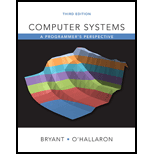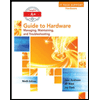
Computer Systems: A Programmer's Perspective (3rd Edition)
3rd Edition
ISBN: 9780134092669
Author: Bryant, Randal E. Bryant, David R. O'Hallaron, David R., Randal E.; O'Hallaron, Bryant/O'hallaron
Publisher: PEARSON
expand_more
expand_more
format_list_bulleted
Concept explainers
Question
Chapter 6, Problem 6.33HW
Program Plan Intro
Given Information:
A 4-way set associative cache is given:
| Index | Tag | V | Bytes 0-3 | Tag | V | Bytes 0-3 | Tag | V | Bytes 0-3 | Tag | V | Bytes 0-3 |
| 0 | F0 | 1 | ED 32 0A A2 | 8A | 1 | BF 80 1D FC | 14 | 1 | EF 09 86 2A | BC | 0 | 25 44 6F 1A |
| 1 | BC | 0 | 03 3E CD 38 | A0 | 0 | 16 7B ED 5A | BC | 1 | 8E 4C DF 18 | E4 | 1 | FB B7 12 02 |
| 2 | BC | 1 | 54 9E 1E FA | B6 | 1 | DC 81 B2 14 | 00 | 0 | B6 1F 7B 44 | 74 | 0 | 10 F5 B8 2E |
| 3 | BE | 0 | 2F 7E 3D A8 | C0 | 1 | 27 95 A4 74 | C4 | 0 | 07 11 6B D8 | BC | 0 | C7 B7 AF C2 |
| 4 | 7E | 1 | 32 21 1C 2C | 8A | 1 | 22 C2 DC 34 | BC | 1 | BA DD 37 D8 | DC | 0 | E7 A2 39 BA |
| 5 | 98 | 0 | A9 76 2B EE | 54 | 0 | BC 91 D5 92 | 98 | 1 | 80 BA 9B F6 | BC | 1 | 48 16 81 0A |
| 6 | 38 | 0 | 5D 4D F7 DA | BC | 1 | 69 C2 8C 74 | 8A | 1 | A8 CE 7F DA | 38 | 1 |
FA 93 EB 48 |
| 7 | 8A | 1 | 04 2A 32 6A | 9E | 0 | B1 86 56 0E | CC | 1 | 96 30 47 F2 | BC | 1 | F8 1D 42 30 |
- The number of physical address bits is represented by “m”.
- The size of cache represented is by “C”.
- The block of size in bytes is represented as “B”.
- Associativity is represented as “E”.
- The number of cache sets is represented by “S”.
- The number of tag bits is represented by “t”.
- The number of block offset bits is represented as “b”.
Expert Solution & Answer
Want to see the full answer?
Check out a sample textbook solution
Students have asked these similar questions
Considering the TM example of binary sum ( see attached)do the step-by-step of execution for the binary numbers 1101 and 11.
Feel free to use the Formal Language Editor Tool to execute it;
Write it down the current state of the tape (including the head position) and indicate the current state of the TM at each step.
I need help on inculding additonal code where I can can do the opposite code of MatLab, where the function of t that I enter becomes the result of F(t), in other words, turning the time-domain f(t) into the frequency-domain function F(s):
I need help with the TM computation step-by-step execution for the binary numbers 1101 and 11.
Formal Language Editor Tool can be used to execute it; Write it down the current state of the tape (including the head position) and indicate the current state of the TM at each step;
Chapter 6 Solutions
Computer Systems: A Programmer's Perspective (3rd Edition)
Ch. 6.1 - Prob. 6.1PPCh. 6.1 - Prob. 6.2PPCh. 6.1 - Prob. 6.3PPCh. 6.1 - Prob. 6.4PPCh. 6.1 - Prob. 6.5PPCh. 6.1 - Prob. 6.6PPCh. 6.2 - Prob. 6.7PPCh. 6.2 - Prob. 6.8PPCh. 6.4 - Prob. 6.9PPCh. 6.4 - Prob. 6.10PP
Ch. 6.4 - Prob. 6.11PPCh. 6.4 - Prob. 6.12PPCh. 6.4 - Prob. 6.13PPCh. 6.4 - Prob. 6.14PPCh. 6.4 - Prob. 6.15PPCh. 6.4 - Prob. 6.16PPCh. 6.5 - Prob. 6.17PPCh. 6.5 - Prob. 6.18PPCh. 6.5 - Prob. 6.19PPCh. 6.5 - Prob. 6.20PPCh. 6.6 - Prob. 6.21PPCh. 6 - Prob. 6.22HWCh. 6 - Prob. 6.23HWCh. 6 - Suppose that a 2 MB file consisting of 512-byte...Ch. 6 - The following table gives the parameters for a...Ch. 6 - The following table gives the parameters for a...Ch. 6 - Prob. 6.27HWCh. 6 - This problem concerns the cache in Practice...Ch. 6 - Suppose we have a system with the following...Ch. 6 - Suppose we have a system with following...Ch. 6 - Suppose that a program using the cache in Problem...Ch. 6 - Repeat Problem 6.31 for memory address0x16E8 A....Ch. 6 - Prob. 6.33HWCh. 6 - Prob. 6.34HWCh. 6 - Prob. 6.35HWCh. 6 - Prob. 6.36HWCh. 6 - Prob. 6.37HWCh. 6 - Prob. 6.38HWCh. 6 - Prob. 6.39HWCh. 6 - Given the assumptions in Problem 6.38, determine...Ch. 6 - You are writing a new 3D game that you hope will...Ch. 6 - Prob. 6.42HWCh. 6 - Prob. 6.43HWCh. 6 - Prob. 6.45HWCh. 6 - Prob. 6.46HW
Knowledge Booster
Learn more about
Need a deep-dive on the concept behind this application? Look no further. Learn more about this topic, computer-science and related others by exploring similar questions and additional content below.Similar questions
- Ensure you answer the question asked at the end of the document. Do not just paste things without the GNS3 console outputsarrow_forward"Do not use AI tools. Solve the problem by hand on paper only and upload a photo of your handwritten solution."arrow_forward"Do not use AI tools. Solve the problem by hand on paper only and upload a photo of your handwritten solution."arrow_forward
- "Do not use AI tools. Solve the problem by hand on paper only and upload a photo of your handwritten solution."arrow_forward"Do not use AI tools. Solve the problem by hand on paper only and upload a photo of your handwritten solution."arrow_forwardSolve this "Do not use AI tools. Solve the problem by hand on paper only and upload a photo of your handwritten solution."arrow_forward
- "Do not use AI tools. Solve the problem by hand on paper only and upload a photo of your handwritten solution."arrow_forward"Do not use AI tools. Solve the problem by hand on paper only and upload a photo of your handwritten solution."arrow_forwardSpecifications: Part-1Part-1: DescriptionIn this part of the lab you will build a single operation ALU. This ALU will implement a bitwise left rotation. Forthis lab assignment you are not allowed to use Digital's Arithmetic components.IF YOU ARE FOUND USING THEM, YOU WILL RECEIVE A ZERO FOR LAB2!The ALU you will be implementing consists of two 4-bit inputs (named inA and inB) and one 4-bit output (named out). Your ALU must rotate the bits in inA by the amount given by inB (i.e. 0-15).Part-1: User InterfaceYou are provided an interface file lab2_part1.dig; start Part-1 from this file.NOTE: You are not permitted to edit the content inside the dotted lines rectangle. Part-1: ExampleIn the figure above, the input values that we have selected to test are inA = {inA_3, inA_2, inA_1, inA_0} = {0, 1, 0,0} and inB = {inB_3, inB_2, inB_1, inB_0} = {0, 0, 1, 0}. Therefore, we must rotate the bus 0100 bitwise left by00102, or 2 in base 10, to get {0, 0, 0, 1}. Please note that a rotation left is…arrow_forward
arrow_back_ios
SEE MORE QUESTIONS
arrow_forward_ios
Recommended textbooks for you
 Systems ArchitectureComputer ScienceISBN:9781305080195Author:Stephen D. BurdPublisher:Cengage Learning
Systems ArchitectureComputer ScienceISBN:9781305080195Author:Stephen D. BurdPublisher:Cengage Learning Principles of Information Systems (MindTap Course...Computer ScienceISBN:9781285867168Author:Ralph Stair, George ReynoldsPublisher:Cengage Learning
Principles of Information Systems (MindTap Course...Computer ScienceISBN:9781285867168Author:Ralph Stair, George ReynoldsPublisher:Cengage Learning Enhanced Discovering Computers 2017 (Shelly Cashm...Computer ScienceISBN:9781305657458Author:Misty E. Vermaat, Susan L. Sebok, Steven M. Freund, Mark Frydenberg, Jennifer T. CampbellPublisher:Cengage Learning
Enhanced Discovering Computers 2017 (Shelly Cashm...Computer ScienceISBN:9781305657458Author:Misty E. Vermaat, Susan L. Sebok, Steven M. Freund, Mark Frydenberg, Jennifer T. CampbellPublisher:Cengage Learning C++ for Engineers and ScientistsComputer ScienceISBN:9781133187844Author:Bronson, Gary J.Publisher:Course Technology Ptr
C++ for Engineers and ScientistsComputer ScienceISBN:9781133187844Author:Bronson, Gary J.Publisher:Course Technology Ptr A+ Guide to Hardware (Standalone Book) (MindTap C...Computer ScienceISBN:9781305266452Author:Jean AndrewsPublisher:Cengage Learning
A+ Guide to Hardware (Standalone Book) (MindTap C...Computer ScienceISBN:9781305266452Author:Jean AndrewsPublisher:Cengage Learning Operations Research : Applications and AlgorithmsComputer ScienceISBN:9780534380588Author:Wayne L. WinstonPublisher:Brooks Cole
Operations Research : Applications and AlgorithmsComputer ScienceISBN:9780534380588Author:Wayne L. WinstonPublisher:Brooks Cole

Systems Architecture
Computer Science
ISBN:9781305080195
Author:Stephen D. Burd
Publisher:Cengage Learning

Principles of Information Systems (MindTap Course...
Computer Science
ISBN:9781285867168
Author:Ralph Stair, George Reynolds
Publisher:Cengage Learning

Enhanced Discovering Computers 2017 (Shelly Cashm...
Computer Science
ISBN:9781305657458
Author:Misty E. Vermaat, Susan L. Sebok, Steven M. Freund, Mark Frydenberg, Jennifer T. Campbell
Publisher:Cengage Learning

C++ for Engineers and Scientists
Computer Science
ISBN:9781133187844
Author:Bronson, Gary J.
Publisher:Course Technology Ptr

A+ Guide to Hardware (Standalone Book) (MindTap C...
Computer Science
ISBN:9781305266452
Author:Jean Andrews
Publisher:Cengage Learning

Operations Research : Applications and Algorithms
Computer Science
ISBN:9780534380588
Author:Wayne L. Winston
Publisher:Brooks Cole